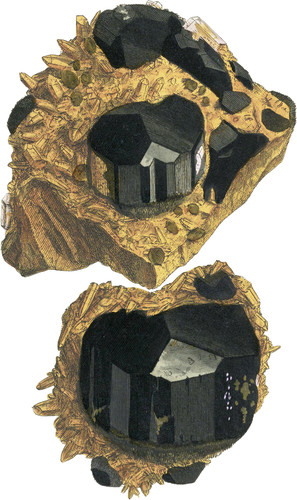 Enlarge
Enlarge
British Mineralogy
Tourmaline
Before closing this work, it is a pleasure to meet with a triumphant and unexpected example of the produce of a country hitherto but rarely quoted for any thing fine. The magnificent Tourmalines, of which I now figure two specimens, may vie with any thing of the kind brought from foreign climes, and will serve to rouse the attention of collectors, who have, I fear, formerly lost many fine things from want of information respecting them, or diligence in the search for them around their own country. I regret this the more, as it has several times happened that my figures have not been taken from such fine specimens as have since been found: such has been remarkably the case here ; for the specimen, tab. 209, was once thought a good one; but although it may afford instruction in the general way, and has crystals of the same form as this, yet it would scarcely be received as an example of the same variety. The spot that has afforded these gems, for surely their beauty entitles them to this appellation, is as I am informed by Mr. Brooke, “a small quarry of red granite near Chudleigh; a barn was built with some of the largest and finest specimens before it was observed by a Gentleman in the neighbourhood, and the walls are yet studded with the large imbedded crystals of Tourmaline, coated with white-wash. They occurred in a cavity in the granite rock, the space being filled with a yellow substance resembling Ckiy.”* Had not this been the case it must have presented a most splendid grotto to the view of the discoverer, for the brilliant black of the Tourmaline is in many parts relieved by fine crystals of Phosphate of Lime, of a very pale colour and frequently tinged with lilac: the basis is a dark reddish Feldspar, penetrated and covered by light greyish brown Quartz in tapering crystals: the ochraceous Clay forms a crust that is difficultly cleared from the Tourmaline, and adheres firmly to the rough surfaces of the Quartz and in the crevices; it was this probably that concealed its beauty and value from the workmen who treated it as dirty stone and so roughly as to leave scarcely one crystal of the Phosphate of Lime unbruised, besides breaking almost all those of Quartz, The largest crystal of Tourmaline I have figured measures two inches and a quarter in diameter; larger may possibly have been found, but as I have been favoured with the choice of Mr. Brooke’s and Dr. Somerville’s specimens, collected on the spot by them together, and also those in the possession of Mr. Mawe, I conceive the two I have figured are very superior ones, the uppermost of which belongs to Mr. Brooke. It is rather curious, but not unfrequently the case, that a particular cavity in a rock will be filled with extraordinary riches, while the most diligent will be foiled in his search after such another treasure, even in the neighbourhood, and it is supposed by those who have visited the spot that it will happen so here.
- * Mr. Loscombe, from whom Mr. Mawe has obtained several specimens, says they are found on the northern declivity of a hill, about a mile and a quarter north of the famous Bovey Coal pit: he observes, that about ten feet below the Tourmaline, is what a Cornish miner would call a kindly gossan (quartz mixed with ochraceous matter) and from the occurrence of Phosphate of Lime along with the Tourmaline, he conceives it would produce Tin ore, which is often found in veins in the neighbouring Granite.

